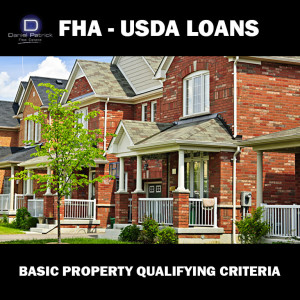Habitability Requirements for FHA and USDA Loans
Home buyers who are looking to purchase a home using an FHA or USDA loan may be surprised to learn that there are certain restrictions or criteria a property must meet in order to be eligible to receive this type of home financing. Because the loans are government backed and usually require little to no money down to purchase, the property will serve as collateral in the event the borrower defaults. Since there is not much equity in the property at the time of purchase, the lender is seeking to protect its investment by ensuring the property meets minimum property standards that will enable to the lender to re-coop as much of its money as possible in the event the lender is forced to foreclose on the property. At the same time, the borrower may be more likely to stay in a home that meets these minimum standards as they will not be stuck with expensive home repair bills from the start.
An appraiser will note the property’s condition during the required property appraisal and report the results on the FHA’s appraisal form in addition to the value the appraiser will assess to the property which must meet or exceed the sale price in order to obtain the loan.
Basic Property Qualifying Criteria for FHA and USDA Loans
- Roof cannot need replacement in 5 years and cannot have more than two layers on it.
- No chipping paint inside or out, this includes exterior structures like a detached garage or barn
- No broken windows
- If property has both a septic system and a well, there must be a 100ft distance between the two. You would also need a water quality test if there is a well which must meet EPA standards
- If property has a septic, and sewer lines are in front of the home in the street and ready for connection, we need estimates for connection. If the cost to connect to sewer is less than 3% of sales price, then FHA requires it be connected to sewer, even with a passing title V. If cost is more than 3%, no connection is necessary.
- If the home is on a private road, there must be a permanently recorded easement
- In general, there can be no safety hazards. Examples include home not having handrails between first and second floors, tripping hazards, loose wires etc…
2015 FHA Additional Rules
- Zoning, legal and non-conforming, the appraiser now needs to verify if property improvements can be rebuilt
- Tanks, there is now no distinction between above and below ground storage tanks
- Attic and crawl spaces, you now need more than a head and shoulders inspection if possible
- Need to verify that mixed use properties comply with zoning
- Photo’s need interior and attic and crawl space photos
- Comps, relaxed from 1 year to as much as 3 years with adequate justification in the report to substantiate older comps
- Can take energy efficiency improvements into value consideration
- High Voltage Lines , now addresses lines that not only go over the dwelling but improvements as well pool, gazebo, etc. need to verify if it is within an easement or within a safe or unsafe distance
- Separate legal description for surplus land is no longer required, highest and best use needs to be determined
- Methamphetamine, if presence of this or other hazardous chemicals are suspected, appraiser must condition for Safe habitation Certification from the municipality
While this list reflects a number of different scenarios and requirements, it is important to note that other criteria may apply depending on the specific property. It is always best to check with your loan officer or real estate professional if you have any questions. It may also be possible to have the seller remedy some of the criteria prior to appraisal if they are willing. If the seller is unwilling or unable to meet the minimum property standards than purchasing the home with an FHA or USDA loan will not be possible and the buyer will unfortunately be forced to look for other property’s that meet these requirements.
For some buyers, other financing options may be available to them that won’t be as strict when it comes to the property standards, but generally this may require them to put more money down which will create more equity in the property. There is also the option of seeking an FHA 203(k) loan which would allow the home buyer to purchase a potential fixer upper with significant problems.
